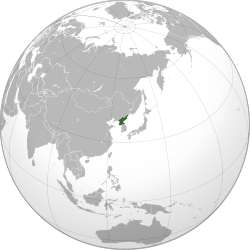North Korea: Forced To Build Kim Monuments
By RFA
Authorities in North Korea have mobilized the residents of a city in North Hamgyong province, including elementary students and the elderly, to construct monuments in honor of the country’s leaders at a tremendous cost of resources and manpower, according to sources.
The mass mobilization has drawn complaints from the inhabitants of Hoeryong city, known as the hometown of current North Korean ruler Kim Jong Un’s grandmother, for committing the country’s meager assets to projects seen by many as “irrelevant to people’s lives,” the sources said.

All inhabitants of Hoeryong have been mobilized to build the structures, which include a “student palace for idolization” and several statues and murals, a source in Hoeryong told RFA’s Korean service on condition of anonymity.
“The North Korean government has even mobilized children in building a new facility for ‘idolization,’ even though it can’t manage the existing student palace that was built before.”
The source said that a two-story student palace had earlier been constructed in the city next to a statue of Kim Jong Suk—the first wife of North Korea’s founder, Kim Il Sung, and mother of former leader Kim Jong Il.
Kim Jong Il died in December last year, paving the way for his son, Kim Jong Un, to assume power.
But the source said that the government could no longer afford to cover the maintenance costs of the older student palace and had let it fall into disrepair from neglect.
Construction of the new student palace has been given priority as part of a national campaign to improve the country and will be “six times larger” than the previous one, the source said.
Hoeryong officials began delivering construction materials to the site in spring this year and shuttered all factories in the city beginning in May, reassigning the local workforce to assist in building the structure.
“In order to reduce the time required to construct the building, the government has recently mobilized people 60 years of age and older, retired party members, members of the Women’s Organization, and youngsters,” the source said.
‘Totally irrelevant’
A university student from Hoeryong, who also spoke on condition of anonymity, said that he had been instructed to assist in the construction of an eight meter (26 feet) tall, 6.5 meter (21 feet) wide mosaic portrait of Kim Jong Il on Osan Hill in the city.
“No matter who you are or what you do, every resident in Hoeryong has been forced to participate in building a mosaic at least once,” the student said.
“More than 2,000 murals and statues have been built all over the country. That has cost quite a lot.”
The source added that Hoeryong city authorities have even required kindergarten students to travel to the mosaic construction site to remove gravel as a “show of loyalty to Kim Jong Il.”
He said some residents had begun to complain that the North Korean government was wasting money and effort in building facilities “totally irrelevant to people’s lives.”
Earlier this year, authorities in Hoeryong were preparing to tear down more than 200 houses in the city’s Osanduk-dong area to make way for a memorial statue in honor of the late Kim Jong Il known as the “Eternal Tower.”
Plans for the tower include a park and other facilities, which sources told RFA was part of a bid to attract North Koreans to what is now a largely secluded area.
Hoeryong authorities have assured residents that new apartments will be built for them within two years, but did not specify when the alternate housing will be assigned to them or where they will be constructed, the sources said.
Construction on the memorial was due to begin in April.
Pricey monuments to the late leader have been constructed across the country since his death, at a time when North Koreans are facing chronic food shortages and many are unable to feed their families.
The U.N. said last autumn that some three million people would require food aid in North Korea this year.
Kim Il Sung’s former official residence—a marble-lined palace—was turned into a mausoleum after his death. The renovation, thought to have cost over U.S. $100 million, was carried out while North Koreans suffered a famine during the 1990s.
Reported by Sung Hui Moon for RFA’s Korean service. Translated by Juhyeon Park. Written in English by Joshua Lipes.

Madness Absolute Madness !
Wander if North Korea have any epidemic of obesity and associated medical problems there? Also: What is the general health and medical state of population there? (Independently verified !)